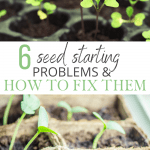Common Seed Starting Problems And How To Fix Them
Starting vegetable seeds indoors is a great way to get a head start on your garden, but seed starting problems can sometimes occur. Learn how to spot the most common seed starting problems and how to resolve them.
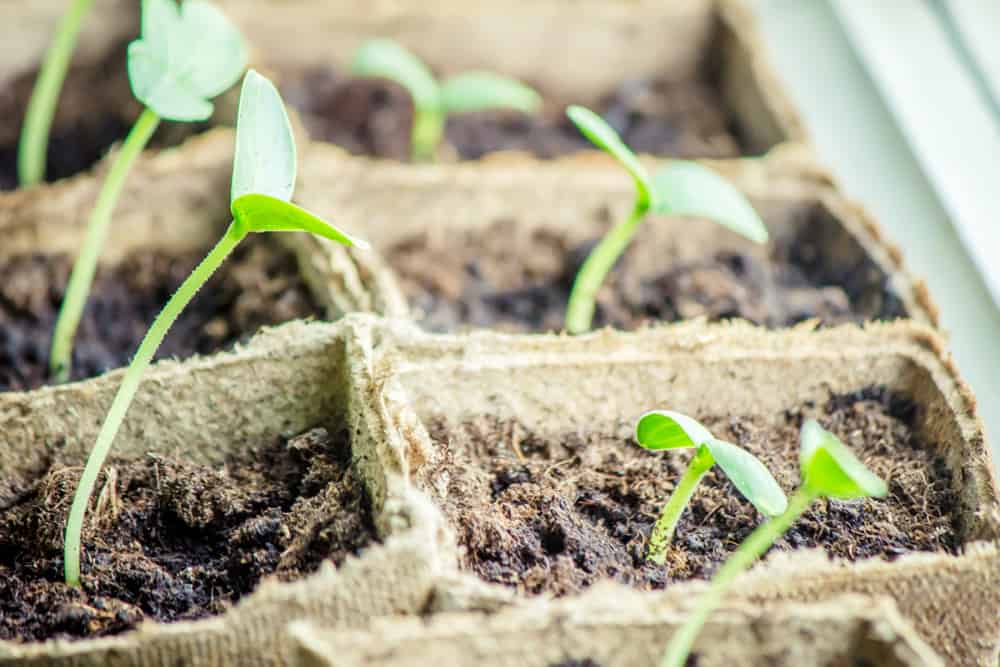
Disclosure: This post contains affiliate links, which means if you make a purchase through these links, we may receive a small commission at no extra cost to you.
It may still be snowing outside, but starting seeds indoors will give you a head start on your garden this spring. With your favorite seeds tucked into peat pellets, it’s only a matter of time before the first hints of green start to poke through. And if all goes well, you’ll have healthy starts with sturdy stems and disease free leaves in just a few weeks.
Even if you do everything right, things don’t always go as planned. From mold issues to leggy seedlings, starts may not take well to the conditions provided. Below we’ll go over the most common seed starting problems and how to prevent them.
Leggy Seedlings
Plants with tall, spindly stems are considered “leggy”. They start flopping over from the weight of their leaves and the stems are usually light in color. This condition means they’re either not getting enough light or receiving a weak amount of light. The scientific term for this is etiolation, and it happens because the seedling is trying to stretch and grow toward light.
You may think window light is enough, but in most cases it’s not. We expose our seedlings to artificial lights for 16-20 hours a day.
If you already have your seedlings under artificial lights, they may not be close enough to the light source. The lights should be about 1-3 inches above the seedlings and should be adjusted as the seedlings grow. We use adjustable chains or strings so our lights can be moved upwards as the seedlings get taller.
If you’re already following these instructions and still have leggy seedlings, try replacing the bulbs in your artificial lights.
Damping Off Disease
If your seedlings fall over at the base and die or if you notice whole patches of seedlings dying off, your seedlings are most likely infected with a fungal infection called damping off disease.
The best way to prevent this pathogen is to use a peat based potting mix, since mixes containing peat have natural antifungal properties. We use Jiffy Peat Pellets and so far have never had problems with damping off disease.
Damping off disease occurs in cold, wet soil with poor soil drainage. Other conditions that encourage this infection include high humidity levels, rich potting soils and too deep of a planting depth.
To discourage damping off disease, either use new seed-starting trays or disinfect your old trays. To disinfect, spray a solution of 10 percent bleach solution or 3% hydrogen peroxide on the trays and let the solution dry before using to kill off pathogens.
Seedlings that are spaced too closely together can also get infected with damping off disease. Air circulation is critical to reducing this pathogen. Position a FAN ON A LOW SETTING to blow air on the seedlings for a few hours each day.
Anecdotal evidence from home gardeners has long suggested that sprinkling CINNAMON over the soil surface of newly planted seeds will effectively combat damping off disease. A recent scientific study has backed this claim by comparing plants sprinkled with cinnamon to those sprinkled with pesticides. The cinnamon was found to be just as effective as the pesticides at reducing damping off disease.
Mold Growth
You may notice a white or gray fuzzy mold develop on the soil surface or even on the seedlings themselves. If you didn’t use sterile seed starting mix or sterilize old starting trays and pots, you may have a fungal infection called botrytis.
This fungal infection can wipe out a whole flat of seedlings and even kill mature plants. This pathogen works quickly to kill seedlings and ruin mature foliage. Plants and seedlings infected will have to be destroyed along with any pots and seed starting trays.
No Germination Or Poor Germination
You wait and wait for a speck of green to pop through the soil, but no luck. Seeds that are old or past their prime are one of the biggest reasons your seeds aren’t germinating. Some seeds start to decline after one or two years, while others stay viable for over a decade.
If you’ve stored seeds from years past and want to check viability, simply dampen a paper towel and place about 20 seeds on the paper towel. Fold the paper towel and place it inside a clear plastic bag in a warm location. Check for germination daily until the last day stated on the seed packet guidelines.
If the germination rate is low, it’s time to order new seeds. Soil temperature that is too cold is another frequent cause of reduced germination. Refer to our soil temperature chart of optimal soil temperatures for vegetable seed germination.
Cotyledons (“Seed Leaves”) Are Stuck In The Seed Coat
The first bits of green that pop through the soil are called cotyledons, and they are vital to the plant, performing photosynthesis and providing essential nutrients. Occasionally cotyledons get stuck inside the seed coat and do not fully extend. If this happens, the first thing to do is nothing. Be patient.
Sometimes the seed coat will fall off on its own in a day or so. If it doesn’t, try dipping the seed coat in water or misting it with a spray bottle and gently try to work the seed coat off with your fingers.
Be careful not to damage the cotyledons, although we have seen plants grow well even if the cotyledons are damaged. It’s not clear why this problem occurs, but one hypothesis is that it happens if seeds are not planted deeply enough. So, if this is a consistent issue for you, try planting seeds a little bit deeper.
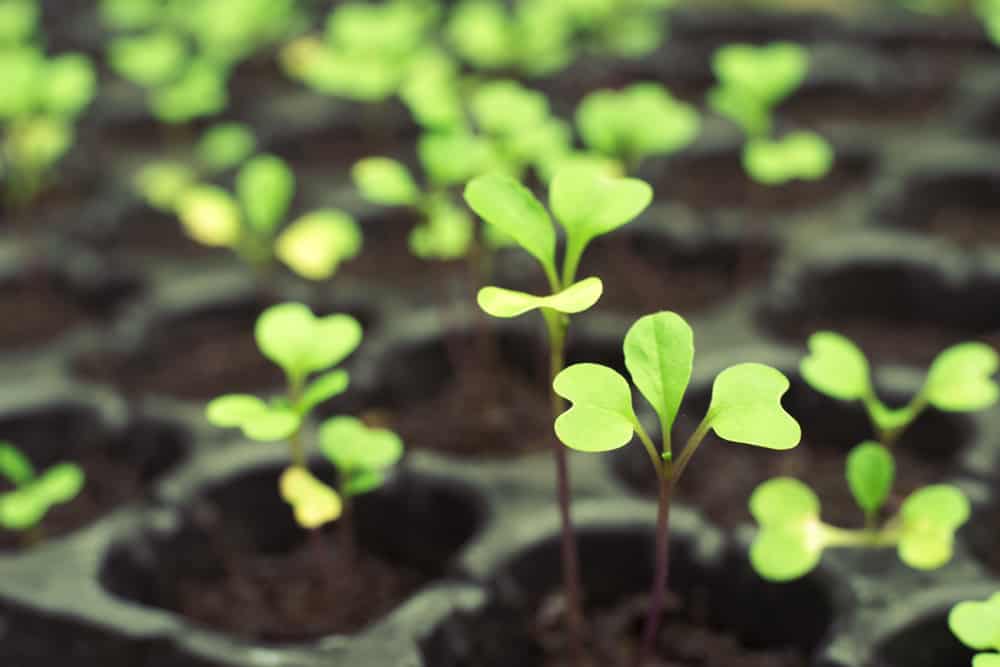
Leaves Turning Yellow, Stunted Growth
Assuming your plants are receiving the proper amount of light, this could be a sign of nutrient deficiency.
If you are growing plants in a potting soil that has organic fertilizer, this often provides enough nutrients to last until you transplant to your garden. However, if you started early and the plants are getting large, you might need to add some additional fertilizer if plants are showing signs like yellowing leaves.
We recommend liquid organic fertilizer derived from kelp and/or fish emulsion. We don’t add too much fertilizer, as this can stress young plants or cause them to grow up rapidly rather than out. Stocky plants are better than tall and leggy. If the fertilizer does not give specific instructions for seedlings, dilute to at least half the formula suggested for established garden plants.
Cotyledons Turn Yellow & Fall Off The Plant
If your plants are old enough to have a few sets of true leaves this is totally normal and nothing to worry about.
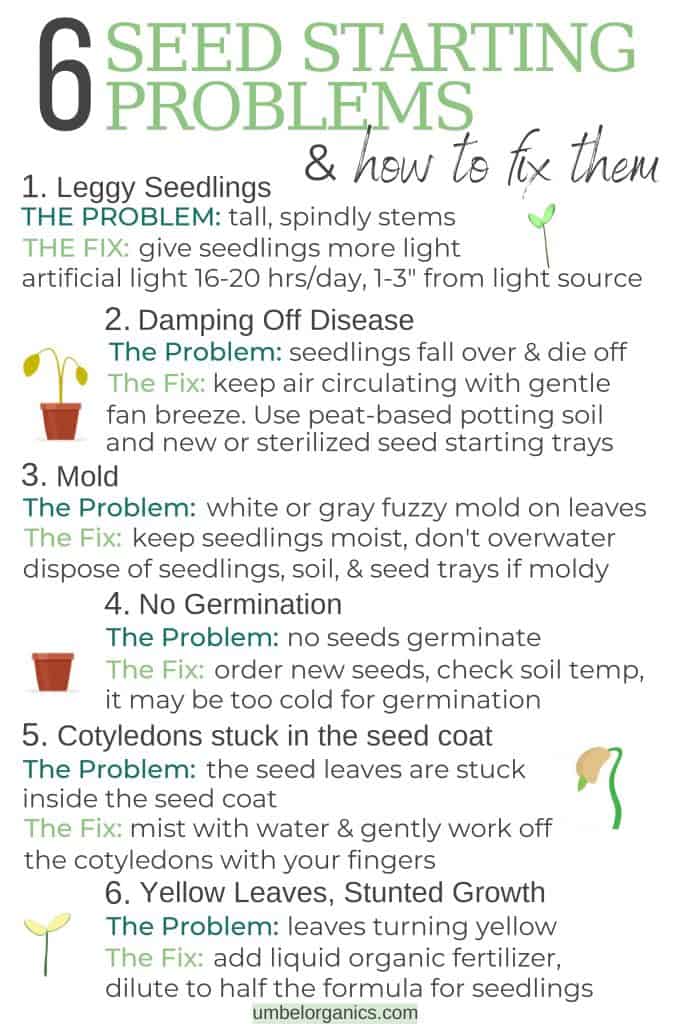
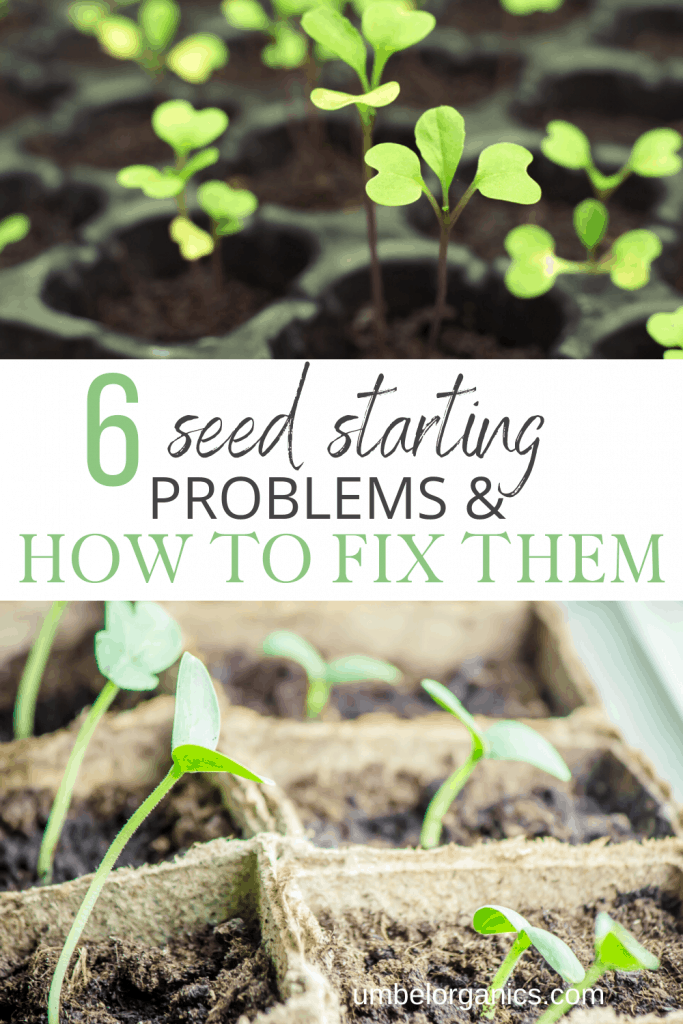
More Gardening Inspiration
Photo images via Adobe Stock. All infographic images created by Umbel Organics.

